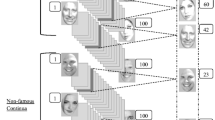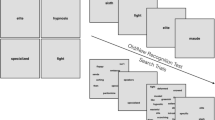Abstract
WHEN an object such as a chair is presented visually, or is represented by a line drawing, a spoken word, or a written word, the initial stages in the process leading to understanding are clearly different in each case. There is disagreement, however, about whether those early stages lead to a common abstract representation in memory, the idea of a chair1–4, or to two separate representations, one verbal (common to spoken and written words), and the other image-like5. The first view claims that words and images are associated with ideas, but the underlying representation of an idea is abstract. According to the second view, the verbal representation alone is directly associated with abstract information about an object (for example, its superordinate category: furniture). Concrete perceptual information (for example, characteristic shape, colour or size) is associated with the imaginal representation. Translation from one representation to the other takes time, on the second view, which accounts for the observation that naming a line drawing takes longer than naming (reading aloud) a written word6,7. Here we confirm that naming a drawing of an object takes much longer than reading its name, but we show that deciding whether the object is in a given category such as ‘furniture’ takes slightly less time for a drawing than for a word, a result that seems to be inconsistent with the second view.
Similar content being viewed by others
References
Schank, R. C., Cog. Psychol., 3, 552–631 (1972).
Anderson, J. R., and Bower, G. H., Human Associative Memory (Wiley, New York, 1973).
Seymour, P. H. K., Br. J. Psychol., 64, 35–49 (1973).
Potter, M. C., Science (in the press).
Paivio, A., Imagery and Verbal Processes (Holt, Rinehart and Winston, New York 1971).
Woodworth, R. S., Experimental Psychology, (Holt, New York, 1938).
Fraisse, P., Percept. mot. Skills, 11, 204 (1960); Annee Psychol., 64, 21–46 (1964).
Wingfield, A., Acta. Psychol., 26, 216–226 (1967); Am. J. Psychol., 81, 226–234 (1968).
Cohen, G., Q. J. exp. Psychol., 25, 557–564 (1973).
Forster, R. I., and Chambers, S. M., J. verbal Learning verbal Behav., 12, 627–635 (1973).
Author information
Authors and Affiliations
Rights and permissions
About this article
Cite this article
POTTER, M., FAULCONER, B. Time to understand pictures and words. Nature 253, 437–438 (1975). https://doi.org/10.1038/253437a0
Received:
Issue Date:
DOI: https://doi.org/10.1038/253437a0
- Springer Nature Limited
This article is cited by
-
Biased information processing and anxiety coping: differences in attentional and approach patterns towards positive cues in repressors
Current Psychology (2023)
-
Identifying task-relevant spectral signatures of perceptual categorization in the human cortex
Scientific Reports (2020)
-
Predicting (variability of) context effects in language comprehension
Journal of Cultural Cognitive Science (2019)
-
Does “a picture is worth 1000 words” apply to iconic Chinese words? Relationship of Chinese words and pictures
Scientific Reports (2018)
-
Spatial coding of object typical size: evidence for a SNARC-like effect
Psychological Research (2015)





